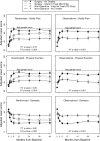Surgical compared with nonoperative treatment for lumbar degenerative spondylolisthesis. four-year results in the Spine Patient Outcomes Research Trial (SPORT) randomized and observational cohorts
- PMID: 19487505
- PMCID: PMC2686131
- DOI: 10.2106/JBJS.H.00913
Surgical compared with nonoperative treatment for lumbar degenerative spondylolisthesis. four-year results in the Spine Patient Outcomes Research Trial (SPORT) randomized and observational cohorts
Abstract
Background: The management of degenerative spondylolisthesis associated with spinal stenosis remains controversial. Surgery is widely used and has recently been shown to be more effective than nonoperative treatment when the results were followed over two years. Questions remain regarding the long-term effects of surgical treatment compared with those of nonoperative treatment.
Methods: Surgical candidates from thirteen centers with symptoms of at least twelve weeks' duration as well as confirmatory imaging showing degenerative spondylolisthesis with spinal stenosis were offered enrollment in a randomized cohort or observational cohort. Treatment consisted of standard decompressive laminectomy (with or without fusion) or usual nonoperative care. Primary outcome measures were the Short Form-36 (SF-36) bodily pain and physical function scores and the modified Oswestry Disability Index at six weeks, three months, six months, and yearly up to four years.
Results: In the randomized cohort (304 patients enrolled), 66% of those randomized to receive surgery received it by four years whereas 54% of those randomized to receive nonoperative care received surgery by four years. In the observational cohort (303 patients enrolled), 97% of those who chose surgery received it whereas 33% of those who chose nonoperative care eventually received surgery. The intent-to-treat analysis of the randomized cohort, which was limited by nonadherence to the assigned treatment, showed no significant differences in treatment outcomes between the operative and nonoperative groups at three or four years. An as-treated analysis combining the randomized and observational cohorts that adjusted for potential confounders demonstrated that the clinically relevant advantages of surgery that had been previously reported through two years were maintained at four years, with treatment effects of 15.3 (95% confidence interval, 11 to 19.7) for bodily pain, 18.9 (95% confidence interval, 14.8 to 23) for physical function, and -14.3 (95% confidence interval, -17.5 to -11.1) for the Oswestry Disability Index. Early advantages (at two years) of surgical treatment in terms of the secondary measures of bothersomeness of back and leg symptoms, overall satisfaction with current symptoms, and self-rated progress were also maintained at four years.
Conclusions: Compared with patients who are treated nonoperatively, patients in whom degenerative spondylolisthesis and associated spinal stenosis are treated surgically maintain substantially greater pain relief and improvement in function for four years.
Figures


References
-
- Atlas SJ, Deyo RA, Keller RB, Chapin AM, Patrick DL, Long JM, Singer DE. The Maine Lumbar Spine Study, Part III. 1-year outcomes of surgical and nonsurgical management of lumbar spinal stenosis. Spine. 1996;21:1787-95. - PubMed
-
- Atlas SJ, Keller RB, Robson D, Deyo RA, Singer DE. Surgical and nonsurgical management of lumbar spinal stenosis: four-year outcomes from the Maine Lumbar Spine Study. Spine. 2000;25:556-62. - PubMed
-
- Malmivaara A, Slätis P, Heliövaara M, Sainio P, Kinnunen H, Kankare J, Dalin-Hirvonen N, Seitsalo S, Herno A, Kortekangas P, Niinimäki T, Rönty H, Tallroth K, Turunen V, Knekt P, Härkänen T, Hurri H; Finnish Lumbar Spinal Research Group. Surgical or nonoperative treatment for lumbar spinal stenosis? A randomized controlled trial. Spine. 2007;32:1-8. - PubMed
-
- Bridwell KH, Sedgewick TA, O'Brien MF, Lenke LG, Baldus C. The role of fusion and instrumentation in the treatment of degenerative spondylolisthesis with spinal stenosis. J Spinal Disord. 1993;6:461-72. - PubMed
Publication types
MeSH terms
LinkOut - more resources
Full Text Sources
Other Literature Sources
Medical

